How Vehicle Inventory Management System Works With VMS
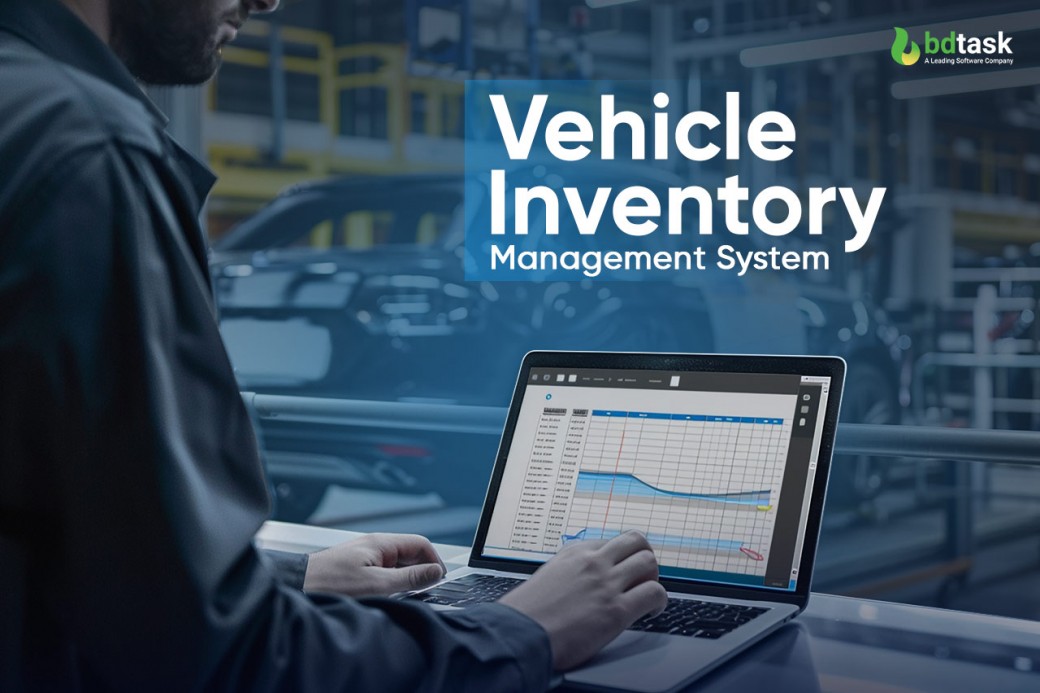
A vehicle inventory management system is a better way to manage your vehicle inventory. A quality inventory management solution can manage & track all the inventory accessories without errors. This system is essential for any dealership to optimize total operations and balance supply and demand. It also plays a good role in improving the customer satisfaction levels. It helps businesses like car dealerships, fleet, car rental, repair shops, and manufacturers to track.
A study by Marketsandmarkets shows that the automotive aftermarket management market will grow to $430.4 billion. This sector is growing because it continues to provide better stock management solutions.
The article will give you a total overview of how the vehicle inventory management system works and the benefits for the vehicle business.
Let's start.
What is Vehicle Inventory Management System
A vehicle inventory management system is an automated software-based system. It's trying to get help for automotive businesses, such as :
- Car dealerships
- Rental services
- Fleet operators effectively
- Track vehicle
- Manage an automobile
- Organise overall vehicle inventories
Manual work in the fleet business is really painful; instead, there is an inventory management centralised platform where all vehicle-related information can be stored, monitored, and updated in real time. You can totally control transparency and accuracy without any human errors. It also helps any dealer to show the availability of vehicles. As a result, vehicles are properly scheduled, tracked, and maintained. One of the positive advantages is its automatic updating of stock, generating sales reports, and monitoring depreciation.
Obviously, it's saving valuable time and maintaining transparency and customer satisfaction.
How A Vehicle Inventory Management System Works
Tracking a vehicle inventory manually is quite a challenge. If something's gone wrong, then the company or your business can lose a considerable amount of money, which can affect the profitability. Since you can maintain this system in a spreadsheet, you have to manage:
- Warranty details
- Stock quantity on order
- Stock cost
- Vehicle assignments
- Vehicle adjustment
- Driver assignments
- Total supplies
- Suppliers used per job & more
Tracking all those at the same time is hard and needs lots of coworkers to maintain it. Sometimes workers do not do it properly. But with the implementation of vehicle inventory, it's done easily. A total digital database, where every vehicle is recorded with its details. An easy process to track down every vehicle model, year, VIN (Vehicle Identification Number), mileage, condition, and ownership status. Whenever a vehicle is bought, sold, rented, or moved, the system automatically updates. Don't worry about manually updating all the data.
On the other hand, with VMS, it's easy to monitor, track, or manage all your fleet business. A well-optimised vehicle management system that can smooth your automotive-related work.
Nine Features of The Inventory Management System In VMS
In any inventory management system, there are some features. It's all about the process of how you can handle the work step by step. Processes like expense, their type, category, location management, stock management, part list, vendor management & more. Let's break down all the parts one by one.
Expense Management
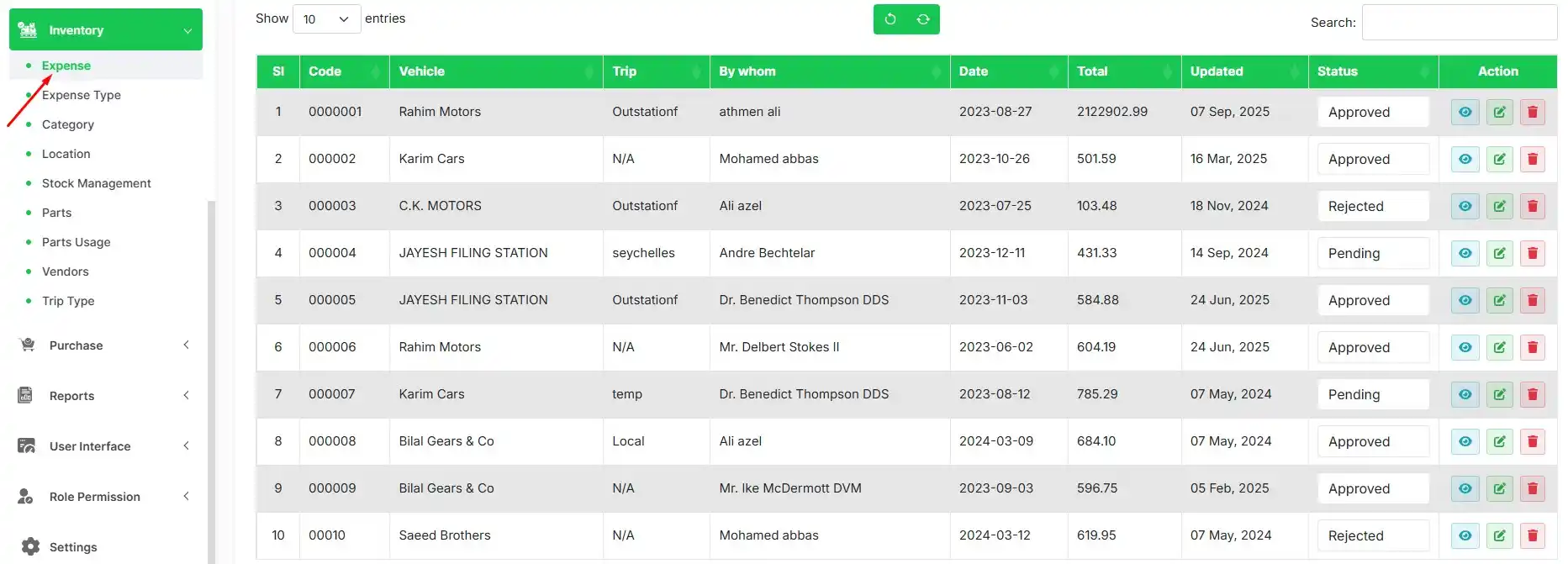
The expenses management tracks all your expenses in your fleet or automotive business. Easily track down fuel expense, maintenance, repairs, parts purchases, insurance, taxes, driver allowances, tolls & others. In these modules, you can create, edit, and take action in individual vehicles. On the other hand, if you need to present any presentation, then use expense reports, which provide transparency and assist in budget forecasting. As a result, a manager can easily analyse which vehicles are consuming higher maintenance costs. It will help fleet managers to make informed decisions about whether to repair or replace.
One of the most important things to know is that it ensures that there is no duplication of data and reduces financial mismanagement. These modules not only reduce the expense but also maintain the financial discipline of your business.
Expense Type

You can see different types of expenses and classify them in this module. It's not just the end with the recording cost. You can also define specific types, such as fuel, routine maintenance, insurance, parts purchase, driver wages, or others. If you want, you can update or delete it, or also modify it as you wish. It improves the financial transparency of inventory and provides a solid expense type report in the vehicle inventory management system. Expense types also support regulatory compliance. This module easily integrates with reporting tools. It is a suitable and effective module for businesses that operate multiple branches or departments.
Category Type

In the category submodules, a fleet manager categorises each part of the vehicle and monitor the quantity. In this section, you can create as many categories as you want. After creating the category, you can activate it or deactivate it at any time. Category features help to maintain better organised data details than a manually spreadsheet form. Suppose you want to find the total tire cost for your fleet business. Then, search in the tire category and easily find all the necessary details. Instead, save some valuable time and get accurate results.
Location Management
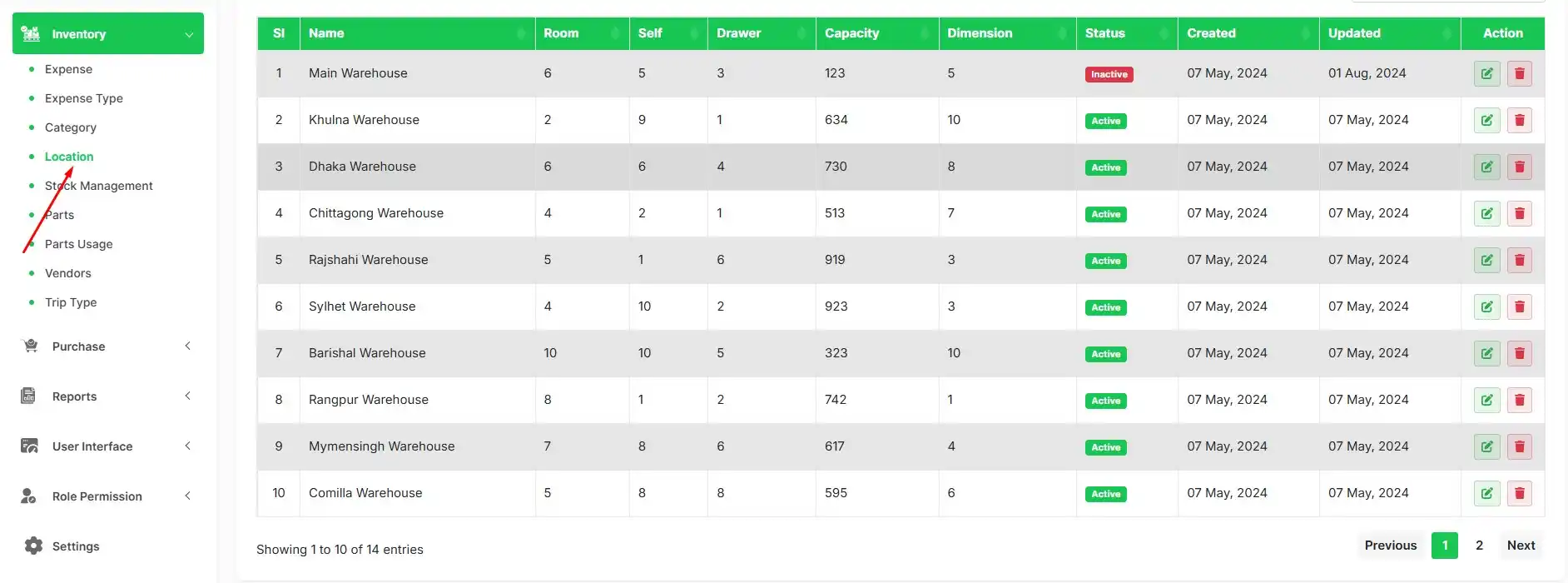
Location management provides a better overview of all the inventory assets' geographical placements. With these submodules, a fleet owner can easily track and manage assets and expenses in different locations. These essential features make sure that every vehicle, part, and expense is tied to a specific area. It gives the manager the power to analyse performance and cost distribution region-wise. You can also compare each location's total expenses with others to identify any unusual costs and take action accordingly.
Stock Management
.webp)
Stock management = Creating a flow of information from purchase to consumption
Stock is an essential part of any business. It's all about ordering, storing, and monitoring your store efficiently. With these features in the car lot management system, you can easily manage and track your assets without any errors. One of the best purposes of having stock management in your system is that it is able to meet customers' demand. Fleet managers can easily track equipment availability without running out of stock or causing delays in delivery times. Obviously, it improves customer satisfaction with accurate answers. It's also essential in the following ways :
- Better decision-making about your car business
- Good warehouse taxi management
- Keep track of waste
- Easily manage refunds and resells
- Help to grow your dream business
In VMS software, easily select the category, then part, and show how many of your stock you have and how many are in your quantity. There are other options to look at how many are left and what the market value is for that remaining quantity. You have the option to filter the time and date for specific results . Learn all that in just a click.
Parts Management
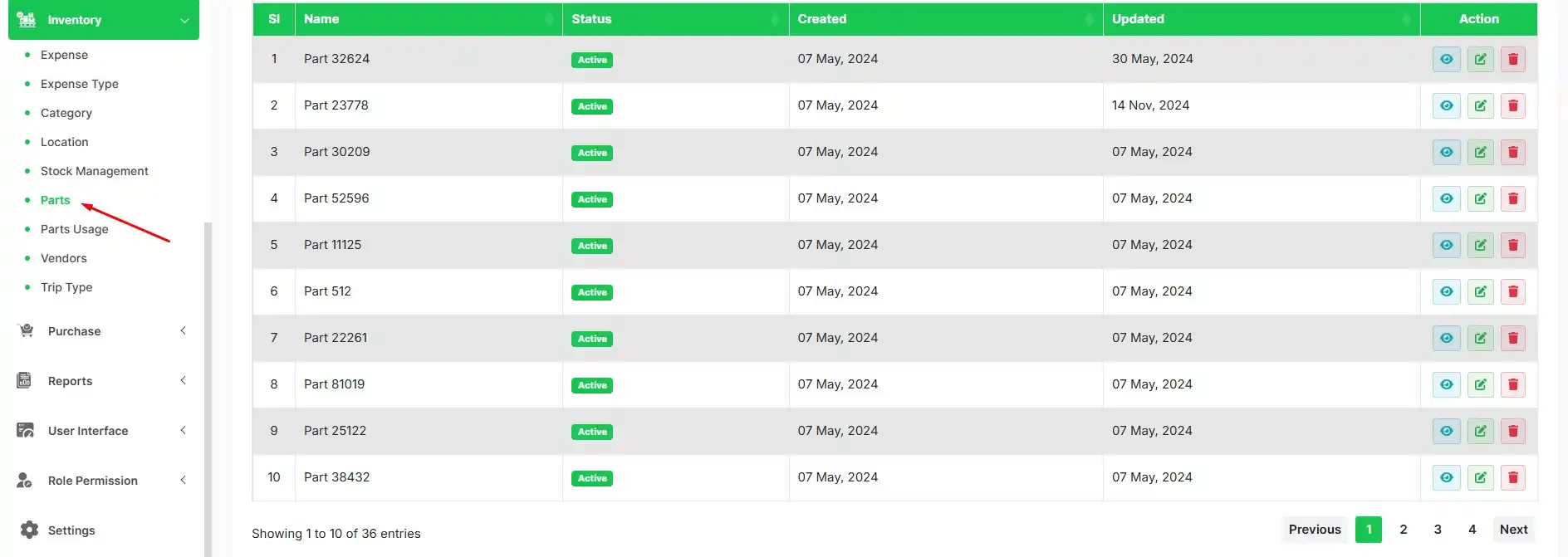
The part management part in the vehicle management software is designed to keep all records of spare parts, accessories, and vehicle components. You can check the availability of the parts and also edit them. If you need any information related to any particular parts, then click and show all the details, like which location is available, its quantity, and whether it is active or not.
With the system, administrators and mechanics quickly find the right part and track its lifecycle, from the day it was added to its latest modifications. This sub-module minimizes errors, prevents duplication, and supports smooth operations.
Parts Usage
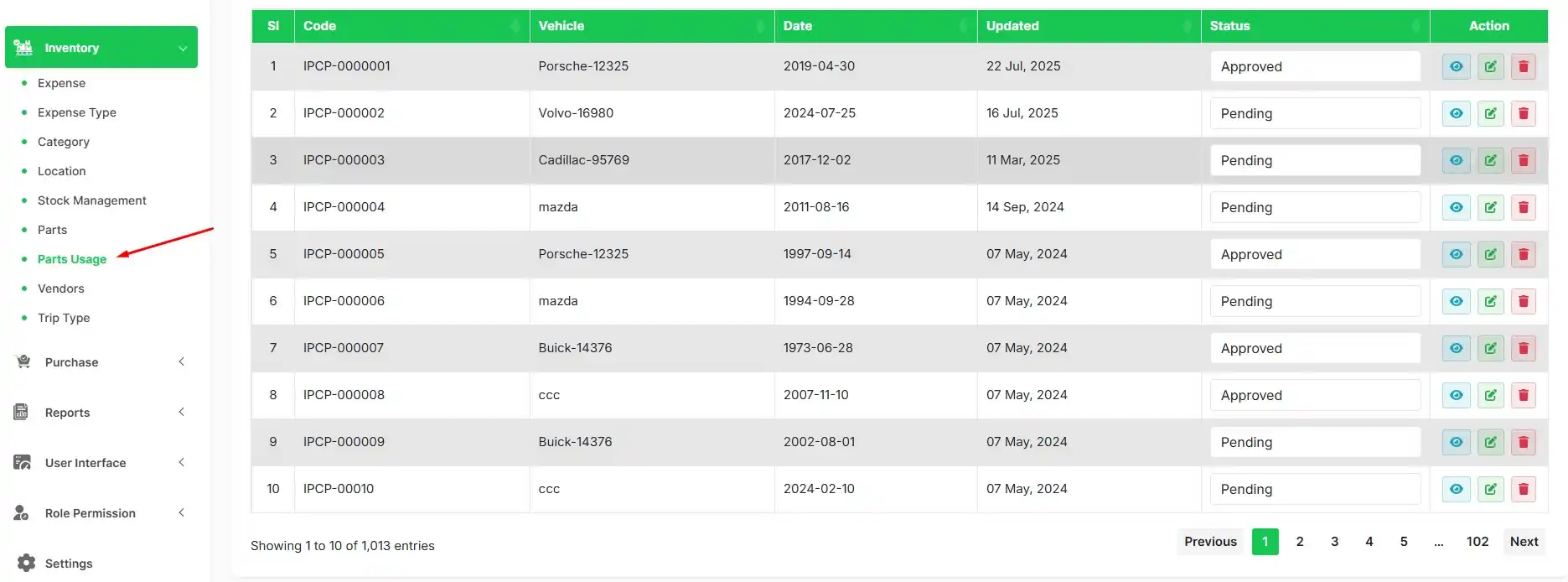
The role of the Part usage section in VMS is to store data every time any part is installed, replaced, or consumed. Part usage controls the cost allocations also. With this feature, companies or fleet owners can easily calculate the exact maintenance cost per vehicle. So that any unusual financial cost does not happen. Another thing to remember is that it's integrated with stock management. Integrates with stock management to automatically update inventory levels. It ensures real-time accuracy in stock data and smooth like butter operations in the fleet business.
Manage Vendors
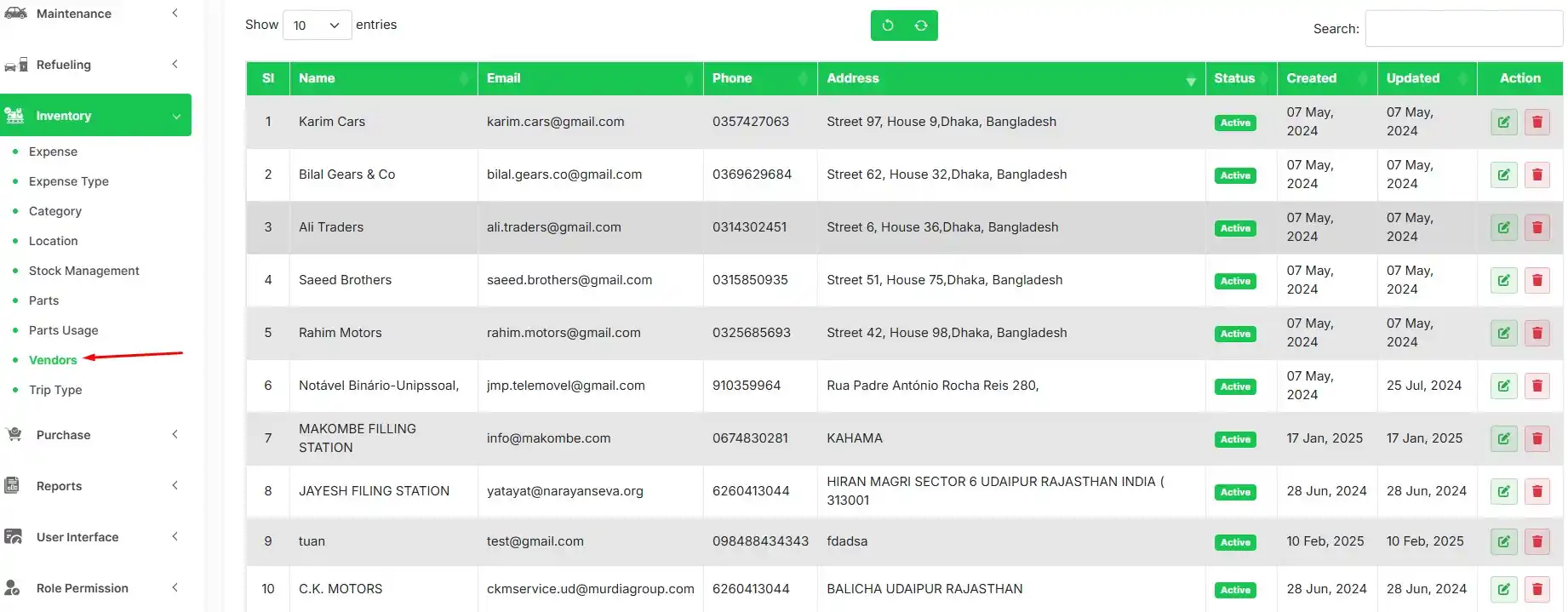
Vendor management maintains a database of all the vendors who supply your inventory materials. It maintains a bond in supplier relationships and procurement processes. You have all of the vendor's information in this feature. Information like :
- Name of particular vendors
- Past transaction history
- Phone number
- Product catalogues & more
On the other hand, vendors can also link up with the Expenses, Parts, and Stock Management features. Vendor management reduces risks of dependency on a single supplier and allows for competitive bidding.
Trip Type

In trip type modules, a fleet manager lists down trip types. It might be local or international. Add as much trip information as you want. Just click on the create trip and name the trip, and you are good to go. A great feature to get details on which are used locally or internationally.
Benefits Of Vehicle Inventory Management System
Apart from all the features of inventory management, it brings revenue to the business. How exactly its do that? Manually managing a spreadsheet in an inventory project is quite risky. A little mistake can lose a quite of money. Instead, using a car inventory management system can reduce the error rate. Without any doubt, this fleet business is growing, and it's a nice path to grow.
Improve Productivity
One of the key advantages of a vehicle inventory management system is that it improves overall productivity and efficiency. When everything is computer-based and automated, it helps to reduce errors in the work. It also minimizes downtime and maximizes vehicle utilization. Staff spend less time searching for individual products. They find extra time to do other important work. So clearly, it improves efficiency, and when the job is done correctly, it generates real revenues.
24/7 Inventory Tracking
Real-time inventory tracking ensures the latest update on your equipment availability. In many places, spare parts and accessories are still maintained manually. It's burn time, and sometimes it confuses stock levels. If an employee uses brake pads for vehicle servicing, the system instantly deducts that item from the available stock. This type of transparency eliminates manual searching and presents a clear inventory picture.
Save Fleet Cost
Proper car inventory management reduces the unnecessary cost of any car business. Many companies lack an accurate estimation of parts, resulting in unnecessary expenses due to poor inventory visibility, as they may spend extra money on parts they already have. So it's easy to reduce the hidden cost when you have a proper digitized system like VMS. However, you can reorder only when necessary by automating the process in your fleet business. As a result, companies can monitor optimal stock levels and minimise waste. Another advantage of using inventory management is that it reduces the risk of theft, misuse, or misplacement of parts.
Analysis & Accurate Forecasting
Proper forecasting depends on accurate historical data, usage patterns, and seasonal demands. So, the inventory management system in your fleet helps estimate how many items are in your inventory and how many you need. If you have less-than-average inventory, the system helps you give alerts. You can easily stock up in advance to avoid a sudden shortage. These proper predictive insights reduce emergency purchases, save money, and ensure ROI.
Vendor Management
Vendor management is now easier than before. In the meantime, it's easy to access all the details of them, including their pricing and more. So you can easily contact them for any product purchase in an emergency situation. On the other hand, you can also compare their supplier parts prices with other vendors. A manager also uses this as an advantage. Managers can then use this data to negotiate discounts, request faster deliveries, or switch to a more reliable vendor if needed.
Customer Satisfaction
When regular maintenance and proper parts are in the manager's hands, product supply goes on time. It directly affects customer satisfaction. We all know that customer satisfaction is really important in any business. When products are delivered on time, it's evident that customers are happy. It's building a positive experience, and they share it with others. It's also built a good brand value and increased its customer base. Increasing customers means generating revenue than before.
Final Notes
After learning of the importance of a vehicle inventory management system, what do you think? Implementing a VMS with inventory facilities, you can change the game of your business. It helps to increase customer satisfaction, better inventory management, no hidden costs and after all, a profit margin for your fleet business.
So why wait!!!!
Implement a good vehicle management system and lead the road with maximum profitability.
FAQs
What Is The Purpose Of A Vehicle Inventory Management System?
The purpose of car inventory management is to properly manage your automotive business and ensure a profit margin.
How Much Does a Vehicle Inventory Management System Cost?
It really depends on your fleet business requirements and how many vehicles you have in your fleet. Standard fleet management software sometimes does the job, but if you have any special features that need to be applied to your fleet software, the price will vary. Usually, the price is
- Basic systems for small businesses ($20–$50) per month
- Mid-range solutions ($100–$500) per month.
- Enterprise-level automotive inventory software for large fleets $1,000 per month
Can I Integrate It With Other Existing Software?
Yes, of course. Most vehicle management software is seamlessly integrated with the vehicle inventory tracking system. In that sense, VMS is an all-in-one solution for managing your fleet.
Is It Suitable For Small Dealership Or Fleet Business Owners?
Yes. Any business can benefit from automotive inventory software. Its features and well-organised work help you track your inventory items properly without errors.










